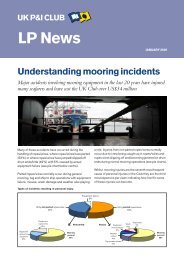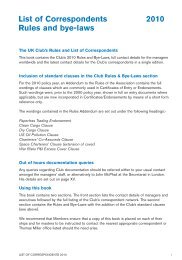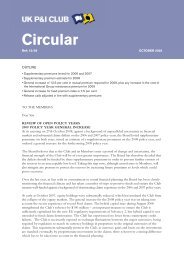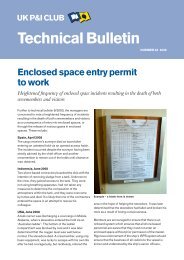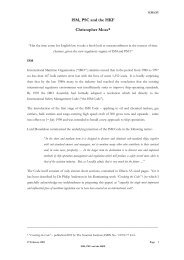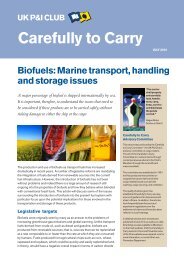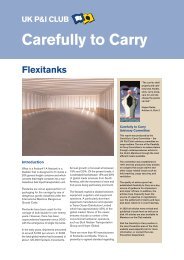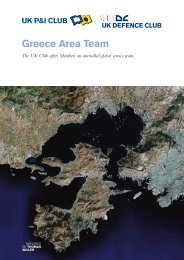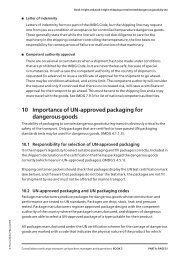Bulk Matters - UK P&I
Bulk Matters - UK P&I
Bulk Matters - UK P&I
Create successful ePaper yourself
Turn your PDF publications into a flip-book with our unique Google optimized e-Paper software.
from the inside of the stow to the outside, and there will<br />
be a gradual drop in the temperature of the air which<br />
moves and the grain in contact with it. Hence water<br />
vapour will be absorbed en route, lowering the dew<br />
point of the air moving towards the periphery of the<br />
stow. Thus it is not possible to make an exact prediction<br />
of what conditions are necessary for cargo sweat to<br />
occur.<br />
Heating up<br />
If there is a temperature differential between the outside<br />
of the stow and the inside, then moisture migration will<br />
result from the mechanism previously described. Such<br />
moisture migration will also occur when one part of the<br />
bulk becomes heated-up for any reason, e.g. insect<br />
infestation, microbiological activity or proximity to a hot<br />
bulkhead. In all these circumstances moisture will<br />
migrate from the warmer region to colder parts of the<br />
stow.<br />
Warmer to cooler<br />
We have illustrated, taking maize as an example, the<br />
reasons why moisture migration occurs. As with maize,<br />
the problem of moisture migration is most evident with<br />
exports of biological materials from warmer climates to<br />
cooler climates. Moisture migration can occur from<br />
many causes but, however the temperature differential<br />
comes about, the result will always be (where the<br />
moisture content is uniform) a movement of moisture<br />
from the warmer to the cooler parts of the cargo.<br />
Moisture migration is observed in cargoes where<br />
‘insect infestation’ occurs. Here, centres of heating<br />
arise from the respiratory heat from the insects and<br />
moisture migrates from these spots to form a wetter<br />
shell in the cooler cargo immediately surrounding the<br />
heated zone. As heating becomes progressive, the<br />
heating zone of course expands as the wetter shell<br />
moves outwards.<br />
A second example is where ‘ship’s heat’ causes a<br />
localised rise in the temperature of the cargo in contact<br />
with the source of the heat – e.g. an uninsulated engine<br />
room bulkhead. Here moisture migrates from the warm<br />
cargo and forms a layer of increased moisture content<br />
in the cooler cargo adjacent to it.<br />
Unfortunately, the straightforward pattern of moisture<br />
movement resulting from a vapour pressure differential<br />
is not the only phenomenon that results from<br />
temperature differential in a cargo. Where temperature<br />
differentials are present, convection currents are set up<br />
owing to the fact that warm air is less dense than cold<br />
air. Thus, if heating occurs within a cargo, there will be a<br />
tendency for moisture to migrate in all directions from<br />
the heating zone. But there will also be a tendency for<br />
hot air to rise from the heating zone, to be replaced by<br />
cooler air coming in from the sides and underneath. The<br />
warm air will carry moisture with it, so that the pattern of<br />
moisture movement will be distorted in a vertical<br />
direction. In fact, where a hot spot occurs in a cargo,<br />
moisture movement is greater in a vertical direction than<br />
either laterally or downwards, because convection<br />
currents reinforce the upward movement of moisture.<br />
Thus for grain loaded warm and subjected to peripheral<br />
cooling, the major amount of moisture movement will be<br />
in a vertical direction, i.e. more water will pass towards<br />
the top of the cargo than towards the sides. If it is not<br />
possible to remove the water migrating to the top region<br />
of the cargo by ventilation, a subject that is discussed<br />
later in this report, more damage may be anticipated in<br />
the top layers than at the sides.<br />
The rate of moisture migration<br />
Having established the causes and the pattern of<br />
moisture migration, we now consider the quantitative<br />
aspects of the phenomenon.<br />
Difference in vapour pressure<br />
The rate at which moisture moves from a warm to a cold<br />
region is dependent to a large extent on the difference<br />
in vapour pressure between the warmer and colder<br />
parts of the cargo. From Table 1 it will be seen that the<br />
vapour pressure of interstitial air of a cargo of maize at<br />
14% moisture content does not increase directly with<br />
temperature. Thus an increase in temperature from<br />
15°C to 25°C will give a vapour pressure increase of<br />
9.2mm Hg, whereas a rise in temperature from 25°C to<br />
35°C will give a vapour pressure increase of 15.2mm<br />
Hg. It therefore follows, that moisture migration will be<br />
greater, all other things being equal, when moisture is<br />
moving from cargo at 35°C to cargo at 25°C than when<br />
moisture is moving from cargo at 25°C to cargo at<br />
15°C, although the temperature difference in both<br />
cases is the same. Thus, when considering rate of<br />
moisture movement within a cargo, not only is<br />
difference in temperature important, but also the ‘actual<br />
temperatures’. A further factor is of course the<br />
differential in temperature in relation to distance – thus<br />
moisture will move more rapidly from cargo at 25°C to<br />
cargo at 15°C if the distance through which it must<br />
travel is only 1m rather than 10m, because it will be<br />
obvious that the vapour pressure gradient is much<br />
greater in the former case. In this respect the ‘thermal<br />
conductivity’ of the cargo in question is of considerable<br />
importance; the lower the conductivity, the slower heat<br />
will move through a cargo, and hence the less the<br />
potential for moisture movement.<br />
Initial moisture content<br />
The initial moisture content is also important. If we<br />
consider a cargo of maize at 14% moisture content<br />
16




